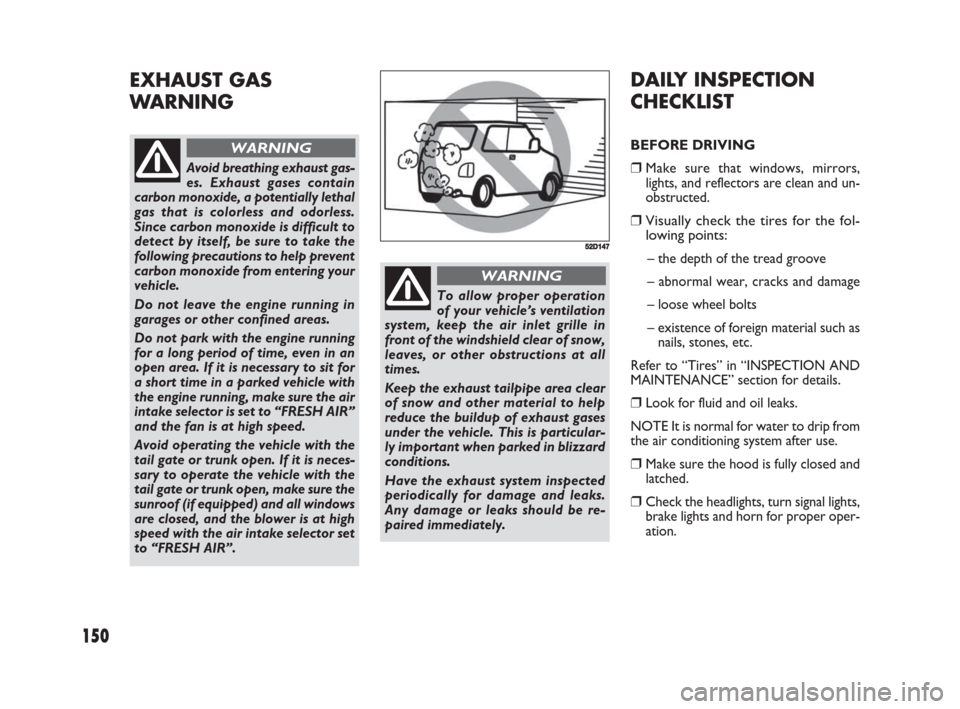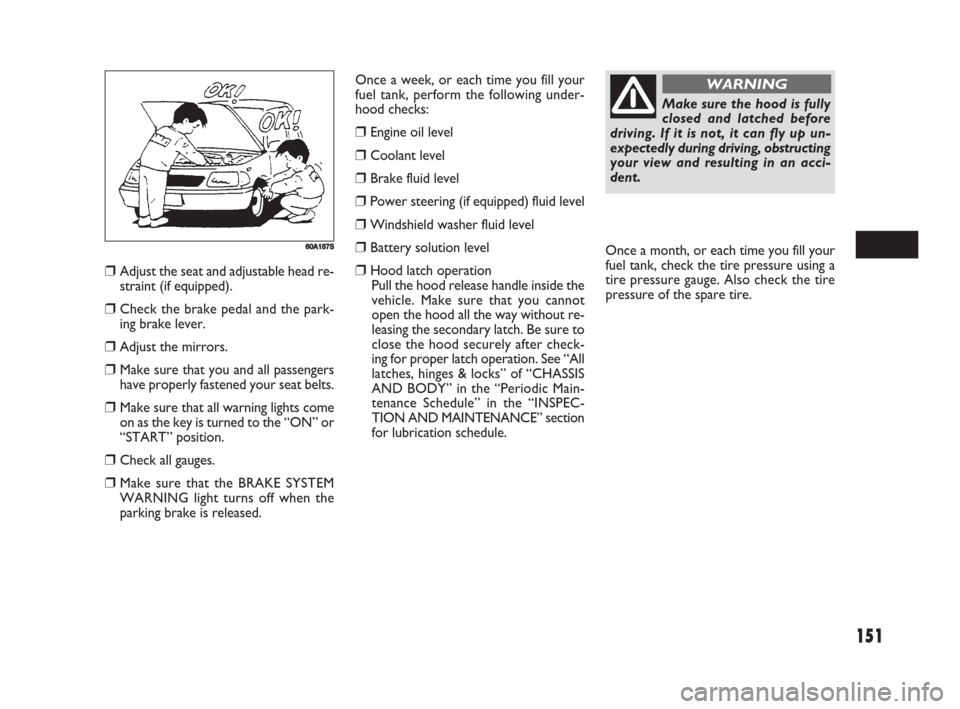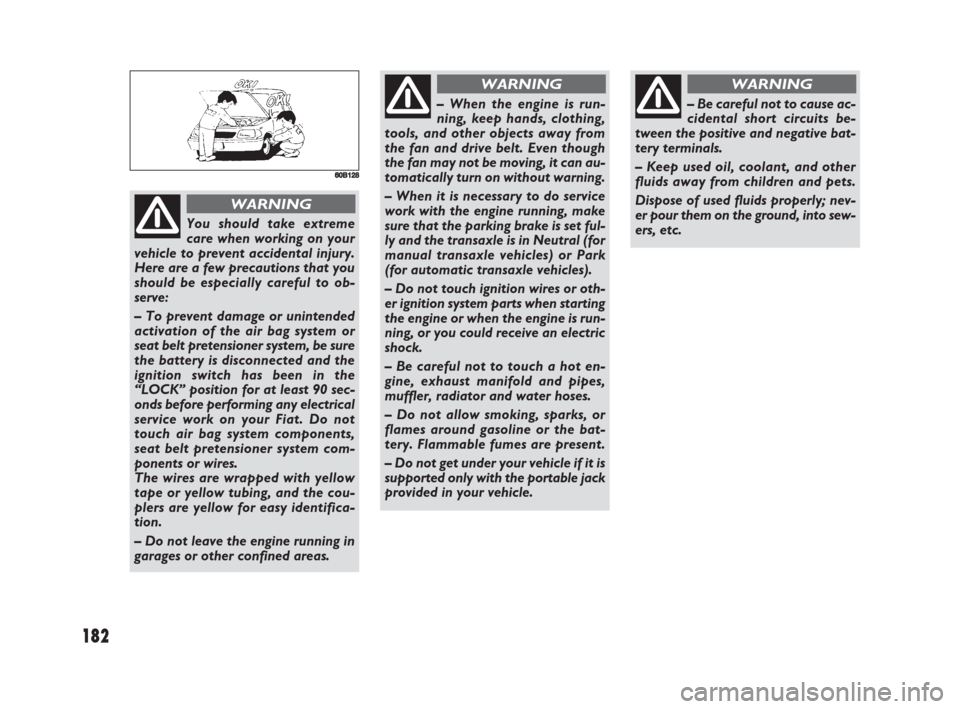2008 FIAT SEDICI engine oil
[x] Cancel search: engine oilPage 151 of 266

150
DAILY INSPECTION
CHECKLIST
BEFORE DRIVING
❒Make sure that windows, mirrors,
lights, and reflectors are clean and un-
obstructed.
❒Visually check the tires for the fol-
lowing points:
– the depth of the tread groove
– abnormal wear, cracks and damage
– loose wheel bolts
– existence of foreign material such as
nails, stones, etc.
Refer to “Tires” in “INSPECTION AND
MAINTENANCE” section for details.
❒Look for fluid and oil leaks.
NOTE It is normal for water to drip from
the air conditioning system after use.
❒Make sure the hood is fully closed and
latched.
❒Check the headlights, turn signal lights,
brake lights and horn for proper oper-
ation.
EXHAUST GAS
WARNING
52D147
Avoid breathing exhaust gas-
es. Exhaust gases contain
carbon monoxide, a potentially lethal
gas that is colorless and odorless.
Since carbon monoxide is difficult to
detect by itself, be sure to take the
following precautions to help prevent
carbon monoxide from entering your
vehicle.
Do not leave the engine running in
garages or other confined areas.
Do not park with the engine running
for a long period of time, even in an
open area. If it is necessary to sit for
a short time in a parked vehicle with
the engine running, make sure the air
intake selector is set to “FRESH AIR”
and the fan is at high speed.
Avoid operating the vehicle with the
tail gate or trunk open. If it is neces-
sary to operate the vehicle with the
tail gate or trunk open, make sure the
sunroof (if equipped) and all windows
are closed, and the blower is at high
speed with the air intake selector set
to “FRESH AIR”.
WARNING
To allow proper operation
of your vehicle’s ventilation
system, keep the air inlet grille in
front of the windshield clear of snow,
leaves, or other obstructions at all
times.
Keep the exhaust tailpipe area clear
of snow and other material to help
reduce the buildup of exhaust gases
under the vehicle. This is particular-
ly important when parked in blizzard
conditions.
Have the exhaust system inspected
periodically for damage and leaks.
Any damage or leaks should be re-
paired immediately.
WARNING
149-166 Fiat16 New GB 3-09-2008 8:15 Pagina 150
Page 152 of 266

151
Once a week, or each time you fill your
fuel tank, perform the following under-
hood checks:
❒Engine oil level
❒Coolant level
❒Brake fluid level
❒Power steering (if equipped) fluid level
❒Windshield washer fluid level
❒Battery solution level
❒Hood latch operation
Pull the hood release handle inside the
vehicle. Make sure that you cannot
open the hood all the way without re-
leasing the secondary latch. Be sure to
close the hood securely after check-
ing for proper latch operation. See “All
latches, hinges & locks” of “CHASSIS
AND BODY” in the “Periodic Main-
tenance Schedule” in the “INSPEC-
TION AND MAINTENANCE” section
for lubrication schedule.Once a month, or each time you fill your
fuel tank, check the tire pressure using a
tire pressure gauge. Also check the tire
pressure of the spare tire.❒Adjust the seat and adjustable head re-
straint (if equipped).
❒Check the brake pedal and the park-
ing brake lever.
❒Adjust the mirrors.
❒Make sure that you and all passengers
have properly fastened your seat belts.
❒Make sure that all warning lights come
on as the key is turned to the “ON” or
“START” position.
❒Check all gauges.
❒Make sure that the BRAKE SYSTEM
WARNING light turns off when the
parking brake is released.
60A187S
Make sure the hood is fully
closed and latched before
driving. If it is not, it can fly up un-
expectedly during driving, obstructing
your view and resulting in an acci-
dent.
WARNING
149-166 Fiat16 New GB 3-09-2008 8:15 Pagina 151
Page 153 of 266

152
Oil consumption: Max. 1.0 L per
1000 km (1 Qt. per 600 miles)
When judging the amount of oil con-
sumption, note that the oil may become
diluted and make it difficult to accurately
judge the true oil level.
As an example, if a vehicle is used for re-
peated short trips, and consumes a nor-
mal amount of oil, the dipstick may not
show any drop in the oil level at all, even
after 1000 km (600 miles) or more of dri-
ving. This is because the oil is gradually be-
coming diluted with fuel or moisture, mak-
ing it appear that the oil level has not
changed.
You should also be aware that the dilut-
ing ingredients evaporate out when the ve-
hicle is subsequently driven at high speeds,
such as on an expressway, making it ap-
pear that oil is excessively consumed af-
ter high- speed driving.STARTING THE ENGINE
BEFORE STARTING THE ENGINE
❒Make sure the parking brake is set fully.
❒Shift into “N” (Neutral) and depress the
clutch pedal all the way to the floor.
Hold it while starting the engine.
ENGINE OIL
CONSUMPTION
It is normal for the engine to consume
some engine oil during normal vehicle op-
eration.
The amount of engine oil consumed de-
pends on the viscosity of the oil, the qual-
ity of the oil and the conditions the vehi-
cle is driven under.
More oil is consumed during high- speed
driving and when there is frequent accel-
eration and deceleration. Under high
loads, your engine also will consume more
oil.
A new engine also consumes more oil,
since its pistons, piston rings and cylinder
walls have not yet become conditioned.
New engines reach the normal level of oil
consumption only after approximately
5000 km (3000 miles) driving.
Make sure that the parking
brake is set fully and the
transaxle is in Neutral before at-
tempting to start the engine.
WARNING
IMPORTANT We recommend that dur-
ing the initial period you do not drive to
full vehicle performance (e.g.: excessive ac-
celeration, long journeys at top speed,
sharp braking, etc.).
IMPORTANT When the engine is
switched off never leave the key into the
ignition switch to prevent pointless cur-
rent absorption from draining the battery.
149-166 Fiat16 New GB 3-09-2008 8:15 Pagina 152
Page 154 of 266

153
STARTING A COLD ENGINE
(for petrol versions)
With your foot off the accelerator pedal,
crank the engine by turning the ignition
key to “START”. Release the key when
the engine starts.
IMPORTANT
❒Stop turning the starter immediately af-
ter the engine has started or the starter
system can be damaged.
❒Do not crank the engine for more than
15 seconds at a time. If the engine does-
n’t start on the first try, wait about 15
seconds before trying again.
If the engine does not start after 15 sec-
onds of cranking, wait about 15 seconds,
then press down the accelerator pedal to
1/3 of its travel and try cranking the en-
gine again. Release the key and accelera-
tor pedal when the engine starts.
If the engine still does not start, try hold-
ing the accelerator pedal all the way to the
floor while cranking. This should clear the
engine if it is flooded.
75J017
STARTING A COLD ENGINE
(for Diesel Engine Model)
Turn the ignition switch to the “ON” po-
sition and wait until the glow plug indica-
tor goes out if it comes on. Crank the en-
gine by turning the ignition key to
“START”. Release the key when the en-
gine starts.
IMPORTANT
❒The starter is allowed to crank the
engine up to 30 seconds. If the engine
failed to start, wait 15 seconds, then
restart cranking. Even if the third
trial failed, consult authorized Fiat
Dealership.
❒
If the engine is started after long time
parking at extremely cold atmosphere
such as the ambient temperature is be-
low –20°C, release ignition key from
start position and stop cranking after
confirming the engine speed increase
around 800 to 1000 rpm.STARTING WARM ENGINE
Crank the engine by turning the ignition
key to “START”. Release the key when
the engine starts.
CAUTION WHEN STOPPING
THE ENGINE WITH
TURBOCHARGER
When stopping the engine after climbing or
high speed driving, let the engine idle for
about one minute or more (if it is not pro-
hibited) to cool down the turbocharger and
engine oil. This is to prevent the engine oil
from over-deteriorating. Deteriorated en-
gine oil will damage the bearings of the tur-
bocharger.
RESTARTING D19AA DIESEL
ENGINE AFTER FUEL-EMPTY
STOP
The engine stops if the engine feels fuel
emptiness. To restart the engine, stop the
vehicle, hold the ignition key in “ON” po-
sition for 5 – 10 seconds to feed fuel, then
perform above engine starting procedure.
149-166 Fiat16 New GB 3-09-2008 8:15 Pagina 153
Page 160 of 266

159
IMPORTANT
❒Never use the “4WD LOCK” mode
when driving on dry paved roads.
Avoid using the “4WD LOCK” mode
when driving on wet paved roads as
much as possible. Use of the “4WD
LOCK” mode in above conditions will
apply excessive force to the driving
system and may cause a critical failure.
Also, the tires may wear faster and fu-
el consumption may be affected ad-
versely.
❒Note that 4WD vehicles are not al-
laround vehicles. Be sure to observe
following instructions when driving
your vehicle.
– Do not drive through water like
crossing a river.
– Do not drive continuously where
front wheels tend to race such as in
the sand and mud.
– When any wheel is in the air for such
reason as running off the road, do
not race it needlessly.
❒If the “4WD AUTO” and the “4WD
LOCK” indicator lights stay on and
come on simultaneously when driving,
there may be something wrong the
4WD system. Have the system in-
spected by an authorized Fiat Dealer-
ship.IMPORTANT Unevenly worn tires can
cause problems in the operation of the
2WD/4WD switch. Be sure to rotate the
tires according to the maintenance sched-
ule. Refer to “Tires” and “Maintenance
Schedule” in the “INSPECTION AND
MAINTENANCE” section for proper tire
rotation procedures.
❒While making turns or accelerating and
decelerating, operating the 2WD/
4WD switch or turning off the key
switch in the “4WD AUTO” or “4WD
LOCK” mode may cause a shock, but
this is not a system malfunction.
❒While driving in the “4WD LOCK”
mode, as the vehicle speed increases,
the driving mode changes to the “4WD
AUTO” mode automatically. Even
when the vehicle speed reduces, on the
other hand, the driving mode does not
return to the “4WD LOCK” mode au-
tomatically. You should press the
“4WD LOCK” switch according to the
driving conditions.
❒Any forcible operation while driving of-
froad in the sand or water or when a
wheel has run off the road, the differ-
ence of the revolution between front
wheels and rear wheels increases
(wheels run idle). If this state continues,
the oil temperature of the driving sys-
tem parts rises.
In such case, the “4WD AUTO” indi-
cator light blinks and the driving mode
changes to the 2WD mode to protect
the driving system parts.
When you operate your vehicle in the
4WD mode continuously, park the ve-
hicle at a safe place and run the engine
idle. After some time, the “4WD AU-
TO” indicator light turns on again and
the driving mode returns to the “4WD
AUTO” mode.
149-166 Fiat16 New GB 3-09-2008 8:15 Pagina 159
Page 182 of 266

181
I I
N N
S S
P P
E E
C C
T T
I I
O O
N N
A A
N N
D D
M M
A A
I I
N N
T T
E E
N N
A A
N N
C C
E E E
60G410
MAINTENANCE SCHEDULE ........................................... 183
MAINTENANCE RECOMMENDED UNDER SEVERE
DRIVING CONDITIONS .................................................... 188
DRIVE BELT .......................................................................... 189
ENGINE OIL AND FILTER ................................................ 189
GEAR OIL .............................................................................. 193
ENGINE COOLANT .......................................................... 195
WINDSHIELD WASHER FLUID ...................................... 198
AIR CLEANER ...................................................................... 198
SPARK PLUGS (Petrol engine).......................................... 199
FUEL FILTER (Diesel engine)............................................. 201
BRAKES .................................................................................. 202
STEERING .............................................................................. 204
CLUTCH PEDAL ................................................................. 205
TIRES ....................................................................................... 205
BATTERY ............................................................................... 210
FUSES ...................................................................................... 212
BULB REPLACEMENT ........................................................ 218
WINDSCREEN - REAR WINDOW WASHER /
WIPERS .................................................................................. 223
AIR CONDITIONING SYSTEM ....................................... 224
8
181-224 Fiat16 New GB 3-09-2008 8:17 Pagina 181
Page 183 of 266

182
660B128
You should take extreme
care when working on your
vehicle to prevent accidental injury.
Here are a few precautions that you
should be especially careful to ob-
serve:
– To prevent damage or unintended
activation of the air bag system or
seat belt pretensioner system, be sure
the battery is disconnected and the
ignition switch has been in the
“LOCK” position for at least 90 sec-
onds before performing any electrical
service work on your Fiat. Do not
touch air bag system components,
seat belt pretensioner system com-
ponents or wires.
The wires are wrapped with yellow
tape or yellow tubing, and the cou-
plers are yellow for easy identifica-
tion.
– Do not leave the engine running in
garages or other confined areas.
WARNING
– When the engine is run-
ning, keep hands, clothing,
tools, and other objects away from
the fan and drive belt. Even though
the fan may not be moving, it can au-
tomatically turn on without warning.
– When it is necessary to do service
work with the engine running, make
sure that the parking brake is set ful-
ly and the transaxle is in Neutral (for
manual transaxle vehicles) or Park
(for automatic transaxle vehicles).
– Do not touch ignition wires or oth-
er ignition system parts when starting
the engine or when the engine is run-
ning, or you could receive an electric
shock.
– Be careful not to touch a hot en-
gine, exhaust manifold and pipes,
muffler, radiator and water hoses.
– Do not allow smoking, sparks, or
flames around gasoline or the bat-
tery. Flammable fumes are present.
– Do not get under your vehicle if it is
supported only with the portable jack
provided in your vehicle.
WARNING
– Be careful not to cause ac-
cidental short circuits be-
tween the positive and negative bat-
tery terminals.
– Keep used oil, coolant, and other
fluids away from children and pets.
Dispose of used fluids properly; nev-
er pour them on the ground, into sew-
ers, etc.
WARNING
181-224 Fiat16 New GB 3-09-2008 8:17 Pagina 182
Page 186 of 266

185
15 30 45 60 75 90 105 120 135 150 165 180
●● ●●●●
●●●● ●●●●●●●
●●●●
● ●●●● ●●●●●●●
●● ●● ●● ●●
●●●●
●●●●
●●
●●●●
●●
●●●●
●●●●●●
●● ●●
●
●● ●●●●
●● ●●●●
●● ●●●●
●● ●●●●
● ●●●● ●●●●●●●
Thousands of km
Check exhaust emissions/smoke
Check cleanness of bonnet and boot locks and lever
cleanness and lubrication
Change spark plugs (change iridium spark plugs every 105,000 km)
Change engine oil and oil filter
Check air cleaner conditions
Replace air cleaner cartridge
Change engine coolant
Change accessory drive belt conditions
Sight inspect fuel tank conditions
Check manual transaxle gear oil level
Change manual transaxle gear oil
Check transmission unit oil level (4x4 version)
Check rear differential oil level (4x4 version)
Change rear differential oil (4x4 version)
(just the first time at 15,000 km)
Check suspension operation
Check steering system (electric drive)
Check engine control system operation
(through diagnostic socket)
Change brake and clutch fluid (or every 2 years)
Change pollen filter (or every 2 years)
181-224 Fiat16 New GB 3-09-2008 8:17 Pagina 185